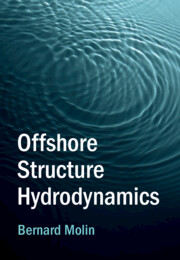Book contents
- Frontmatter
- Contents
- Preface
- Acknowledgments
- Symbols
- Abbreviations
- 1 Introduction
- 2 Environmental Conditions
- 3 Wave Theories
- 4 Wave and Current Loads on Slender Bodies
- 5 Flow-Induced Instabilities
- 6 Large Bodies: Linear Theory
- 7 Large Bodies: Second-Order Effects
- 8 Large Bodies: Other Nonlinear Effects
- 9 Model Testing
- Appendix A: Introduction to Potential Flow Theory
- Appendix B: Hydrostatics
- Appendix C: Damped Mass Spring System
- Appendix D: The Boundary Integral Equation Method
- Author Index
- Subject Index
- References
4 - Wave and Current Loads on Slender Bodies
Published online by Cambridge University Press: 31 January 2023
- Frontmatter
- Contents
- Preface
- Acknowledgments
- Symbols
- Abbreviations
- 1 Introduction
- 2 Environmental Conditions
- 3 Wave Theories
- 4 Wave and Current Loads on Slender Bodies
- 5 Flow-Induced Instabilities
- 6 Large Bodies: Linear Theory
- 7 Large Bodies: Second-Order Effects
- 8 Large Bodies: Other Nonlinear Effects
- 9 Model Testing
- Appendix A: Introduction to Potential Flow Theory
- Appendix B: Hydrostatics
- Appendix C: Damped Mass Spring System
- Appendix D: The Boundary Integral Equation Method
- Author Index
- Subject Index
- References
Summary
This chapter applies to bodies that are small compared to the wave lengths, of dimensions similar or smaller than the wave amplitude. As a result separation cannot be neglected and semi-empirical methods are usually applied to formulate the wave and current loading. The Reynolds number is introduced and the different flow regimes, for a circular cylinder in current, are illustrated. The Morison equation is introduced and applied to the wave loading upon cylinders. Experimental values of the inertia and drag coefficients, vs the Reynolds and Keulegan-Carpenter numbers, are presented. The deficiencies of the Morison equations, in complex flows, are emphasized. Alternatives such as the independent flow-field formulation, or wake models, are introduced. The oscillatory lift force, in steady current, is introduced and the Strouhal number and reduced velocity are defined.
Keywords
- Type
- Chapter
- Information
- Offshore Structure Hydrodynamics , pp. 93 - 131Publisher: Cambridge University PressPrint publication year: 2023

